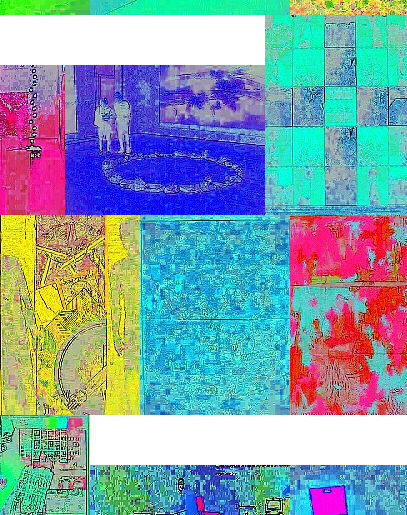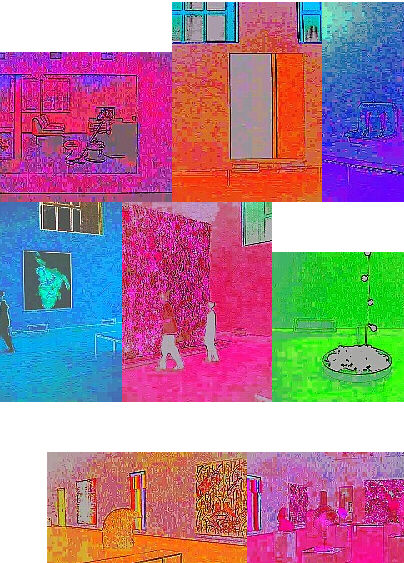 
| |
2002: Looking through the 'arts & literature' sections of Tout Fait, it is clear that many Duchamp inspired artworks are indeed reenactments of one kind or another. It all fits though since even Duchamp reenated his work--the readymade redux, Boite edition, Green Box, etc.
2002: Two of the (lesser known) Kahn buildings I visited and photographed last week are the Radbill and Pincus buildings of Philadelphia Psychiatric Hospital, now called Belmont Rehab. Like most hospitals these days, Belmont is an accumulation of different buildings now all together via demolitions, additions, and expansions. Two facades of the Radbill building have recently been renovated (they somehow remained original for the most part), and one side of the Pincus building is original and in good, stable condition.
These buildings are pretty obscure Kahn architecture. I had known these buildings fairly well during the early 1990s, but not as Kahn buildings, rather because my brother was often a patient there then. I didn't learn that they were Kahn buildings until 2000 when I purchased a used copy of Architecture In Philadelphia: A Guide. What intrigues me now is that these buildings date 1949-53, which is exactly the same time as the Yale Art Gallery,1950-53. Basically, I'm asking why is the Yale Art Gallery so very well known, while Radbill and Pincus barely register a single blip of recognition?
I suppose an easy answer is that the Yale Art Gallery is a far superior building, and that Yale is more likely to publicize its architecture (and the art in it), for sure more likely than a psychiatric hospital anyway. It might also be that a stigma was somehow always attached to Radbill and Pincus, the same type of stigma attached to its patients (worse then, but still existent today as well).
Radbill is largely clad in slate, and has odd sun-baffles (if that's what they are supposed to be) projecting over the windows on the facades facing west. The slate panels started falling off about a decade ago, so only two slate facades remain (and they're the ones now restored). One can compare the use of slate paneling here with the use of slate paneling at the Bryn Mawr dormitory (1960-64).
The multi-purpose room of the Pincus building is probably the most recognizable Kahn at Belmont today. Two of its walls (but now just one wall) were rows of floor to ceiling windows, and each window had a movable (sliding up and down) panel so that the fenestration pattern was adjustable. It looks like the panels were made stationary a long time ago, and the fenestration is now a fixed checker-board pattern. I do (now) recall that a slide image of this room and its windows were seen by me during some design lecture my first year of architecture school (1975).
In doing all this recent research into Kahn's architecture of the early 1950s and prior, it becomes clear that most of Kahn's clients then were Jewish and/or Jewish institutions. Besides Ahavath Israel, Adath Jeshurun, and Philadelphia Psychiatric Hospital, about a dozen private houses, half of which were built, all appear to be for Jewish clients. It wouldn't surprise me if much of Kahn's 'networking' back then can actually be credited to his wife, Esther Israeli Kahn, a highly educated women, and a long-standing pillar of Philadelphia's Jewish community herself.
I'm mentioning all this because I believe it is indicative of how Kahn really began to achieve his greatness as an architect. Beyond the adage that "behind every great man there is a great woman," Kahn also had early exposure to great clients. So, before Kahn stepped up into the 'limelight' after the Yale Art Gallery, he was already at a nice, elevated place essentially created by Philadelphia's Jewry.
I am fascinated by the story of the last attempt to restore the Temple of Jerusalem (circa 350s) by emperor Julian the Apostate. Julian was the son of one of Constantine's half brothers, husband to Constantine's youngest daughter Helena (who they now believe was also buried with her sister Constantina at what is today Santa Costanza at Rome), and brief reviver of Paganism and Hellenism within the eastern half of the Roman Empire. I'm not intending to be disrespectful, but I can't help but believe that Julian sanctioned the restoration of the Temple only out of spite to his immediate Christian Imperial ancestors--Constantine, Helena, and Eutropia built all of Christianity's first great churches on Christianity's most sacred sites, and Julian, clever devil that he was, simply wanted to do them all one better! As I mentioned here before, the full story of the last restoration (attempt) of the Temple of Jerusalem is an interesting story all on its own.
2004: Otto was surprised to learn that Otto Dix now-a-days (or is it daze?) enjoys Bonsai as expressionist art. Apparently, the Bonsai play a role in some new quasi religious allegory painting series entitled Prehistoric Virtual Art History.
|



